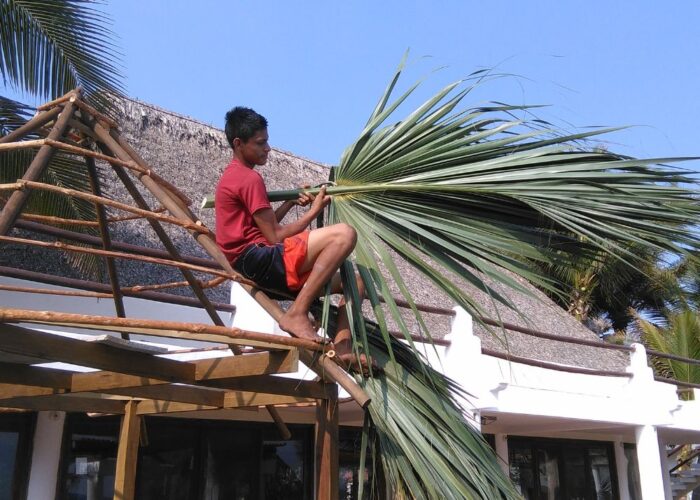-
26-04-2024, 03:41 PM #1
 Silver member
Silver member
- Ngày tham gia
- Nov 2015
- Bài viết
- 98
How to Build a Traditional Thatched Roof with Palm Fronds: A Step-by-Step Guide
How to make thatch roof with palm fronds?
How to make thatch roof with palm fronds? Making a thatch roof with palm fronds is a traditional and environmentally friendly way to construct a roof.

Here's a basic guide on how to do it:- Gather Materials: You'll need palm fronds, preferably from a palm tree with long, sturdy leaves. Make sure they are dry and not too brittle.
- Prepare the Structure: Before you start thatching, ensure that the structure you're covering is sturdy and properly built. This could be a simple frame made of wood or bamboo.
- Start Layering: Begin at the bottom of the roof and work your way up. Lay the fronds horizontally along the roof's slope, with the leafy ends pointing downwards. Overlap each layer to provide adequate coverage and prevent water leakage.
- Secure the Fronds: Use natural materials like twine or rope to tie the fronds to the roof structure. Make sure they are tightly secured to withstand wind and rain.
- Trim Excess: Trim any excess length from the fronds to maintain a neat and uniform appearance. You can use a sharp knife or machete for this.
- Continue Layering: Keep adding layers of fronds until the entire roof is covered. Make sure to overlap each row to ensure water resistance.
- Finishing Touches: Once the roof is fully thatched, you can add a ridge cap along the peak to provide extra protection and to give the roof a finished look. This can be made from bundled fronds or other suitable materials.
- Maintenance: Regularly inspect the thatched roof for signs of wear or damage, especially after heavy rain or strong winds. Replace any damaged fronds promptly to prevent water leaks and maintain the integrity of the roof.
Remember that thatched roofs require periodic maintenance and may need to be replaced every few years depending on the climate and conditions they are exposed to. Additionally, check local building codes and regulations before constructing a thatched roof, as they may have specific requirements or restrictions.View more random threads:
- Top Bác Sĩ Làm Hồng Nhũ Hoa Uy Tín Ở Đà Nẵng – Công Nghệ Laser Chuẩn Y Khoa
- Một số lí do mà bạn nên chọn mua đồ gỗ
- Những nghi lễ cổ truyền về nông nghiệp của người M’nông
- Lộ ảnh Quang Hải đi ăn cùng bồ mới tình quá tình
- Văn hóa Đắk Nông là nguồn cảm hứng bất tận!
- Khu dự án Stella Residence tầm nhìn trọn vẹn
- Làm Hồng Vùng Kín Bằng Laser – S Có An Toàn Không? Có Phải Kiêng Gì Sau Khi Làm?
- Imperium Town Nha Trang tiện ích tối ưu sống phong cách
- Bí Quyết Chăm Sóc Vùng Kín Sau Sinh: Làm Sao Để Phục Hồi Nhanh Và An Toàn?
- Dự án nhà phố cao cấp Lamia Bảo Lộc công viên rộng
Các Chủ đề tương tự
-
Mastering the Art of Willow Basket Weaving: A Step-by-Step Guide
Bởi Thanhcongcraft trong diễn đàn Rao vặt tổng hợpTrả lời: 0Bài viết cuối: 23-02-2024, 04:17 PM -
Entertain and Enrich: A Guide to Chinchilla Chew Toys
Bởi Thanhcongcraft trong diễn đàn Rao vặt tổng hợpTrả lời: 0Bài viết cuối: 24-01-2024, 05:27 PM -
How to Craft a Handmade Rattan Basket: A Step-by-Step Guide
Bởi Thanhcongcraft trong diễn đàn Rao vặt tổng hợpTrả lời: 0Bài viết cuối: 03-01-2024, 04:03 PM -
A Step-by-Step Guide for an Eco-Friendly Garden Project: Bamboo Plants Pot
Bởi Thanhcongcraft trong diễn đàn Rao vặt tổng hợpTrả lời: 0Bài viết cuối: 26-12-2023, 03:58 PM -
How to Craft Your Own Bamboo Flute: A Step-by-Step Guide
Bởi Thanhcongcraft trong diễn đàn Rao vặt tổng hợpTrả lời: 0Bài viết cuối: 18-12-2023, 03:44 PM



 Trả lời kèm Trích dẫn
Trả lời kèm Trích dẫn





Vòng đeo dương vật nên được sử dụng khi nam giới gặp phải một số vấn đề sinh lý nhất định, chẳng hạn như: Rối loạn cương dương: Khi nam giới không thể duy trì sự cương cứng đủ lâu để quan hệ tình...
Các anh nên dùng vòng đeo dương...